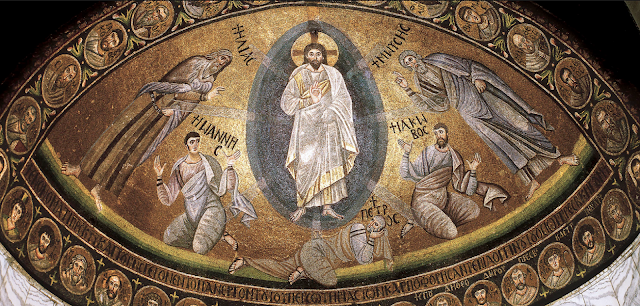Transfiguration
 |
| Transfiguration, Saint Catherine's Monastery, Sinai, Egypt, c. 565 AD |
The Transfiguration of our Lord (6/19 August) is elevated to a position among the Twelve Great Feasts in the Orthodox calendar. Though an ancient tradition in the East, interestingly it was only included as a feast in the Western rites much later, in the 15th century – to commemorate the victory over Islam in Belgrade. [Read about the Siege of Belgrade in 1456 to get the lowdown – but in short, it was a Christian coalition victory over the Ottomans and so huge, the Pope decreed that noon bells should be rung for ever more in remembrance.] The 6th-century mosaic [above] of the Transfiguration is displayed on the apse at Saint Catherine's in Sinai, its central placing attests to the weighty subject matter and importance of this feast.
This isn't an easy feast to unravel like say, Theophany (the Baptism of Christ) – where the Holy Trinity is revealed with Christ in the flesh, the Father (as a voice) and the Holy Spirit in the shape of a dove. We take the Baptism of Christ as a blueprint for one of the mysteries of our Church and through water and through the Holy Spirit we put on Christ, the new Man and are confirmed in our faith.
It's tempting to look at Transfiguration as an event that can similarly have a mirror event for us, where perhaps we get to 'shine' and be remade. I purposely use the shallow language of popular culture here because for one, I have had an unquestionably shallow understanding of the feast day. It's easy to take it at face value: who doesn't love a transformation with a literal, albeit terrifying and startling, wow factor that saw James, John and Peter topple down the mountain? Certainly the splendour of God is on show here, but today I am going to look beyond that.
For us here in the Southern Hemisphere (particularly in Melbourne), Holy Transfiguration occurs as winter's death knell sounds, as the buds on fruit trees just start to blossom but the sky still hangs like sheet metal. Hearing about Christ's face shining as bright as the Sun brings a bright promise. The priest blesses fruit (which have associations with harvest time, or summer) after the service – apples and grapes usually. This goes back to Apostolic Tradition, found in Christian writing from about 235 AD. Maybe the reason for the blessing is a time of year thing, in Greece at least, it's right on the beginning of grape harvests. Transfiguration is almost at the end of the church calendar too, so the general mood is, ends and beginnings or a reconciliation between the Old and the New.
Importantly, the Transfiguration took place during the Jewish Festivals of Booths:
The Jewish Festival of Booths was a feast of the dwelling of God with men, and the transfiguration of Christ reveals how this dwelling takes place in and through the Messiah, the Son of God in human flesh. There is little doubt that Christ’s transfiguration took place at the time of the Festival of Booths, and that the celebration of the event in the Christian Church became the New Testamental fulfillment of the Old Testamental feast in a way similar to the feasts of Passover and Pentecost.
(From Orthodox Church in America)
We look to Christ, and perhaps we wonder, among all these beginnings and ends, maybe we can be similarly transformed or renewed, too. [At this point in the year, who doesn't need a break or a change?] The Transfiguration points more to revelation though – God reveals that Christ is his Son but also, by showing the majesty of Christ, God reveals that His Son's future suffering and sacrifice is voluntary. Christ tells His apostles that he must go to Jerusalem and to suffer many things, and be killed and to rise on the third day.
Reading the Kontakion below really drove home the point of Transfiguration (and why it's such a pertinent choice for the name of a monastery) – it's about choosing the life in Christ, to walk in His steps and to choose freely to suffer in His name.
So that when they would behold You crucified, They would understand that Your suffering was voluntary.
Though here, Christ tells the cowering Peter, James and John, not to tell anyone (not yet) what they saw on (maybe) Mount Tabor (the case has never been settled about where this occurred).
Kontakion (Tone 7)
- On the Mountain You were Transfigured, O Christ God,
- And Your disciples beheld Your glory as far as they could see it;
- So that when they would behold You crucified,
- They would understand that Your suffering was voluntary,
- And would proclaim to the world,
- That You are truly the Radiance of the Father!
For me, now, this feast is about hope, about promise, about the future.
We heard this voice which came from heaven when we were with Him on the holy mountain. And so we have the prophetic word confirmed, which you do well to heed as a light that shines in a dark place, until the day dawns and the morning star rises in your hearts-St Peter (2 Peter 1:10-19)


Comments
Post a Comment